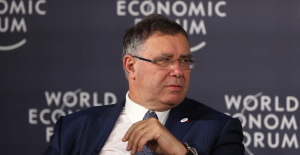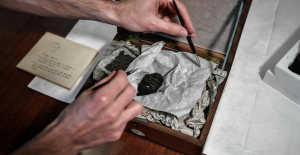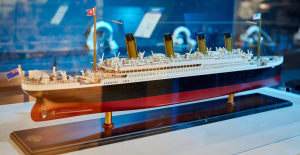In Rome, one of the most famous statues of Antiquity is being restored. A little larger than life, the Apollo of Belvedere is a fragile marble. Its last restoration dates back to the 1990s, when its internal framework was completed and repaired, carried out in the 19th century by the master neoclassical sculptor Antonio Canova.
The last intervention actually somewhat weakened one of the legs of this beautiful walking god. We must therefore resume this treatment. For this, the marble executed during the Antonine dynasty (between 96 and 192 AD) will have to be dismantled, because it is in fact a puzzle pieced together from remains.
When, during the Renaissance, probably on the site of Antium, a port located about sixty kilometers southeast of Rome, this Roman copy of a missing Greek bronze was discovered, it immediately caused a sensation.
Here rests the best memory of Leochares, a sculptor who lived in the 4th century BCE, working notably on the mausoleum of Halicarnassus. He is the legendary inventor of this type of hunting Apollo (he was originally supposed to hold a bow) and eternally young. Michelangelo, for example, was enamored of this plastic perfection, drawing inspiration from it for his monumental David, Glory of Florence, or even for his Bacchus. Countless worshipers followed.
Let us cite, among the most famous, the brilliant sculptor of the Baroque age Bernini (see his Triumphant Perseus, same weighting, same proportions and expressive force). Or, later, Bonaparte, who confiscated the piece in 1797 from the Vatican, taking it to the Louvre in 1800 as the most brilliant of his trophies.
But let's return to the moment of discovery. A cardinal, Giuliano Della Rovere, bought the Apollo and placed it in the garden of his palace, Place des Saints-Apôtres. Then, when he became pope under the name Julius II (1503-1513), he moved it to Vatican Hill, to the Belvedere Palace, hence its name.
Also read: “Statues, objects of piety and hatred: the example of Greek and Roman Antiquity”
Since then, usually visible with the Laocoon, the Antinous, the Venus Felix or the Tigris River in the alcoves of the pivotal octagonal courtyard of what is now the Pio-Clementino Museum, the masterpiece, listed under the number 1015, is a global icon. All ancient history textbooks have it illustrated. As early as the 18th century, the founder of art history and modern archaeology, the German Johann Joachim Winckelmann, considered this Roman statue to be the supreme expression of Greek art, “the highest ideal of 'art among all the ancient works that have come down to us.'
Constantly disseminated, formerly thanks to casts, marble replicas or bronze prints as well as via engravings, today star of tourists' selfies, this representation of the god of arts and beauty will royally resume, after a few months of restoration, his path to the summit of human genius.

 B:SM will break its investment record this year with 62 million euros
B:SM will break its investment record this year with 62 million euros War in Ukraine: when kyiv attacks Russia with inflatable balloons loaded with explosives
War in Ukraine: when kyiv attacks Russia with inflatable balloons loaded with explosives United States: divided on the question of presidential immunity, the Supreme Court offers respite to Trump
United States: divided on the question of presidential immunity, the Supreme Court offers respite to Trump Maurizio Molinari: “the Scurati affair, a European injury”
Maurizio Molinari: “the Scurati affair, a European injury” Irritable bowel syndrome: the effectiveness of low-carbohydrate diets is confirmed
Irritable bowel syndrome: the effectiveness of low-carbohydrate diets is confirmed Beware of the three main sources of poisoning in children
Beware of the three main sources of poisoning in children First three cases of “native” cholera confirmed in Mayotte
First three cases of “native” cholera confirmed in Mayotte Meningitis: compulsory vaccination for babies will be extended in 2025
Meningitis: compulsory vaccination for babies will be extended in 2025 When traveling abroad, money is a source of stress for seven out of ten French people
When traveling abroad, money is a source of stress for seven out of ten French people Elon Musk arrives in China to negotiate data transfer and deployment of Tesla autopilot
Elon Musk arrives in China to negotiate data transfer and deployment of Tesla autopilot Patrick Pouyanné, CEO of TotalEnergies, is very reserved about the rapid growth of green hydrogen
Patrick Pouyanné, CEO of TotalEnergies, is very reserved about the rapid growth of green hydrogen In the United States, a Boeing 767 loses its emergency slide shortly after takeoff
In the United States, a Boeing 767 loses its emergency slide shortly after takeoff A charred papyrus from Herculaneum reveals its secrets about Plato
A charred papyrus from Herculaneum reveals its secrets about Plato The watch of the richest passenger on the Titanic sold for 1.175 million pounds at auction
The watch of the richest passenger on the Titanic sold for 1.175 million pounds at auction Youn Sun Nah: jazz with nuance and delicacy
Youn Sun Nah: jazz with nuance and delicacy Paris Globe, a new international theater festival
Paris Globe, a new international theater festival Skoda Kodiaq 2024: a 'beast' plug-in hybrid SUV
Skoda Kodiaq 2024: a 'beast' plug-in hybrid SUV Tesla launches a new Model Y with 600 km of autonomy at a "more accessible price"
Tesla launches a new Model Y with 600 km of autonomy at a "more accessible price" The 10 best-selling cars in March 2024 in Spain: sales fall due to Easter
The 10 best-selling cars in March 2024 in Spain: sales fall due to Easter A private jet company buys more than 100 flying cars
A private jet company buys more than 100 flying cars This is how housing prices have changed in Spain in the last decade
This is how housing prices have changed in Spain in the last decade The home mortgage firm drops 10% in January and interest soars to 3.46%
The home mortgage firm drops 10% in January and interest soars to 3.46% The jewel of the Rocío de Nagüeles urbanization: a dream villa in Marbella
The jewel of the Rocío de Nagüeles urbanization: a dream villa in Marbella Rental prices grow by 7.3% in February: where does it go up and where does it go down?
Rental prices grow by 7.3% in February: where does it go up and where does it go down? Even on a mission for NATO, the Charles-de-Gaulle remains under French control, Lecornu responds to Mélenchon
Even on a mission for NATO, the Charles-de-Gaulle remains under French control, Lecornu responds to Mélenchon “Deadly Europe”, “economic decline”, immigration… What to remember from Emmanuel Macron’s speech at the Sorbonne
“Deadly Europe”, “economic decline”, immigration… What to remember from Emmanuel Macron’s speech at the Sorbonne Sale of Biogaran: The Republicans write to Emmanuel Macron
Sale of Biogaran: The Republicans write to Emmanuel Macron Europeans: “All those who claim that we don’t need Europe are liars”, criticizes Bayrou
Europeans: “All those who claim that we don’t need Europe are liars”, criticizes Bayrou These French cities that will boycott the World Cup in Qatar
These French cities that will boycott the World Cup in Qatar MLS: new double for Messi who offers victory to Miami
MLS: new double for Messi who offers victory to Miami PSG-Le Havre: Ramos on his way, Kolo Muani at the bottom of the hole… Favorites and scratches
PSG-Le Havre: Ramos on his way, Kolo Muani at the bottom of the hole… Favorites and scratches Football: Vasco da Gama separates from its Argentinian coach Ramon Diaz
Football: Vasco da Gama separates from its Argentinian coach Ramon Diaz F1: for the French, Ayrton Senna is the 2nd best driver in history ahead of Prost
F1: for the French, Ayrton Senna is the 2nd best driver in history ahead of Prost

















